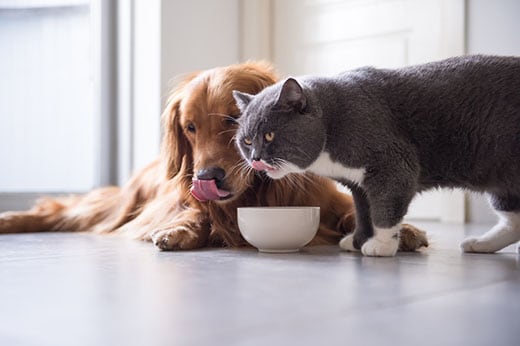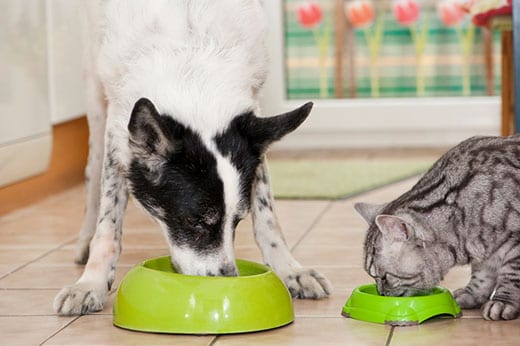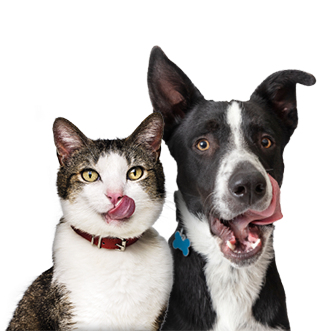
-
Find the right food for your pet
Take this quiz to see which food may be the best for your furry friend.
Find the right food for your pet
Take this quiz to see which food may be the best for your furry friend.
Featured products
 Small & Mini Savory Stew with Chicken & Vegetables Dog Food
Small & Mini Savory Stew with Chicken & Vegetables Dog FoodA delicious complement to the nutrition of Science Diet Small & Mini 7+ dog food
Shop Now Adult 7+ Perfect Digestion Chicken, Whole Oats & Brown Rice Recipe Dog Food
Adult 7+ Perfect Digestion Chicken, Whole Oats & Brown Rice Recipe Dog FoodScience Diet's breakthrough nutrition supports ultimate digestive well-being & healthy microbiome for dogs age 7+
Shop Now Adult Healthy Cuisine Roasted Chicken, Carrots & Spinach Stew Dog Food
Adult Healthy Cuisine Roasted Chicken, Carrots & Spinach Stew Dog FoodDelicious roasted chicken paired with tender vegetables in a succulent stew
Shop NowFeatured products
 Adult 7+ Senior Vitality Chicken & Vegetable Stew Cat Food
Adult 7+ Senior Vitality Chicken & Vegetable Stew Cat FoodImproves Everyday Ability to Get Up & Go
Shop Now Adult Savory Entrée Can Variety Pack Cat Food
Adult Savory Entrée Can Variety Pack Cat FoodPrecisely balanced nutrition with the delicious taste of savory minced chicken to help fuel the energy needs of cats during the prime of their life
Shop Now Adult 7+ Tender Tuna Dinner Cat Food
Adult 7+ Tender Tuna Dinner Cat FoodWith delicious chunks in a decadent gravy
Shop Now -
Dog
- Dog Tips & Articles
-
Health Category
- Weight
- Food & Environmental Sensitivities
- Urinary
- Digestive
- Joint
- Kidney
-
Life Stage
- Puppy Nutrition
- Adult Nutrition
- Senior Nutrition
Cat
- Cat Tips & Articles
-
Health Category
- Weight
- Skin & Food Sensitivities
- Urinary
- Digestive
- Kidney
-
Life Stage
- Kitten Nutrition
- Adult Nutrition
Featured articles
 Does My Pet Hate Me?
Does My Pet Hate Me?Learn tips for bonding with your pet if you've ever thought, 'My dog doesn't like me, or 'Why do I have a standoffish cat?'
Read More Why Are Dogs and Cats So Cute?
Why Are Dogs and Cats So Cute?If waggy puppy dog tails and furry kitten yawns make you swoon, you're not alone. Why are cats so cute? And, dogs too! Let's find out!
Read More Do Dogs and Cats have Belly Buttons?
Do Dogs and Cats have Belly Buttons?Learn whether cats & dogs have belly buttons like humans, what the function is, and if there are any health concerns associated with it.
Read More -


When it comes to mealtime, it's not uncommon for cats and dogs to get curious about what lingers in their furry sibling's bowl. You're not alone if your dog ate cat food once or twice, or if your cat ate dog food or treats — the occasional food swap isn't a big deal. But, if it becomes part of their daily routine, it's time to correct this behavior.
Let's discover why your pets shouldn't share the same kibble or eat each other's foods, what happened inside your pet's body last time your dog ate cat food (and vice versa) and how we can discourage meal swapping once and for all.

Problems With Pets Sharing Foods
It may seem easy to simply fill a big bowl with one food and let all your pets munch and crunch as they desire throughout the day, but there are several reasons why this isn't recommended. For starters, you have no idea how much food each pet is consuming. Are they overeating? Not eating enough?
Let's say you do feed each pet individually, but you have a sneaky pup who likes to eat the cat's dinner for dessert. Your dog may be ingesting too many calories for the day, which could lead to obesity and other related health issues. Also, when a dog eats cat food, they're not getting the proper ratio of protein, fiber and other nutrients needed to maintain their healthy lifestyle. This can lead to gastrointestinal problems, strain on the liver and kidneys, pancreatitis, or a number of other issues. The same can be true if your cat is sneaking your dog's food. Not to mention, cats require a few nutrients, like taurine and arachidonic acid (a type of at) that are not required by dogs, and therefore, not always monitored in dog food. In the long run, a cat eating dog food may experience nutrient deficiencies whereas a dog eating cat food is more likely to experience problems associated with excess energy or nutrients.
Is one of your pets eating therapeutic food? Therapeutic foods are specially made for dogs or cats experiencing specific conditions that can be managed with nutrients at levels (higher or lower) than are found in "regular" foods. Extra care should be taken to make sure only the pet that needs this food eats it. If you do find that the food was eaten by another pet in the household, call your veterinarian to learn about possible reactions or concerns, as well as next steps to keep your pet healthy.

Feed Your Pet Foods Formulated for Their Species
Because of dogs' and cats' unique biology each species needs a different balance of nutrients. The best dog and cat food brands consider your pet's biology before formulating the pet food. They will also take things such as lifestage, health conditions, certain pet food allergies, breed size (for dogs), activity level, and a number of other factors into consideration before crafting a food that is right for a certain type of dog or cat.
This matters because all of those factors contribute to the overall health of your dog or cat. Think about it, you wouldn't put the wrong type of gasoline into your car, would you? So, while you shouldn't be too concerned if a kibble or two gets swiped, you should discourage them from sharing each other's food when possible.


Tasty Tips
Young pets may need several visits in their first year for vaccinations. Adult pets generally benefit from annual check-ups, while senior or special-needs pets might require more frequent visits.
Tips to Discourage Pet Food Sharing
Thankfully, keeping your pets' noses out of each other's bowls is possible with a little planning and forward thinking. The Cummings Veterinary Medical Center at Tufts University explains that you can keep your pets focused on their own meals by trying the following tips:
- Separate your pets during meal times. This might mean your cat gets fed in the kitchen while your pup eats in the living room. The physical distance between the pets encourages them to eat their own foods, peacefully.
- Try using automatic feeders. These can be positioned in each pet's dedicated area of the home. If their spots aren't accessible by other pets, they can become the perfect feeding places to ensure there's no food swapping. Just remember to keep your cat's food away from their litter box; many cats are picky eaters don't want to eat where they defecate. Would you?
- Stagger your feeding times. If your space is limited, feed one pet at a time and then put their bowl up when they're finished eating. Monitor the feeding time to be sure no other pets are nudging in to get the food out of the bowl. This may take a little extra attention, but it's easier than caring for a sick pet.
- Make a cat meal box. If your primary concern is the dog getting into the cat's food, try using a covered litter pan (minus the litter) for a feeding station. The dog can't get inside of the enclosure and your cat will feel safe while they eat their kibble. Win-win!
- Training: The best method for keeping your cat and dog away from each other's food is to train them both. Discourage them when they get near their sibling's bowl with words like "No!" and reward them for being good by placing treats in their respective bowl. Keeping a watchful eye on them during feeding time early on is important to help them learn this behavior.
If you're still having trouble feeding your pets separately, seek the guidance of a pet trainer who can help you modify your pets' behaviors. Or, let your vet know your dog ate cat food (or your cat ate dog food); they may be able to share some feeding tricks to curb these habits.
Cat food is for cats. Dog food is for dogs. It really is best to feed them their respective food to ensure they get the proper nutrition they need and deserve. A random treat swap or hoovering a stray kibble from the floor won't hurt your pet, but it's not a good idea to offer up one big bowl of food each day and assume all of your pets are being nourished in the ways their bodies need. If you're unsure which types of food would be ideal for your pets, chat with your vet about your pets' current health conditions, ages and nutrient needs. After all, your pets deserve the best.


Angela Tague is a pet mom and writer living in the Midwest. When she's not making a mess in the kitchen, exploring nature trails with her dog, or attending a yoga workshop, she's writing full-time for multiple lifestyle and technology brands. You can find her on Twitter and LinkedIn @AngelaTague.
Related products

With delicious chunks in a decadent gravy

Supports energy level and beautiful fur in mature cats

Improves Everyday Ability to Get Up & Go

Precisely balanced nutrition with the delicious taste of savory minced chicken to help fuel the energy needs of cats during the prime of their life
Related articles

Learn tips for bonding with your pet if you've ever thought, 'My dog doesn't like me, or 'Why do I have a standoffish cat?'

Learn whether cats & dogs have belly buttons like humans, what the function is, and if there are any health concerns associated with it.

If waggy puppy dog tails and furry kitten yawns make you swoon, you're not alone. Why are cats so cute? And, dogs too! Let's find out!

Discover how your pets might be impacted by the loss of another. Learn how to recognize their signs of grieving & how to help them cope with their loss.

Put your pet on a diet without them knowing
Our low calorie formula helps you control your pet's weight. It's packed with high-quality protein for building lean muscles, and made with purposeful ingredients for a flavorful, nutritious meal. Clinically proven antioxidants, Vitamin C+E, help promote a healthy immune system.
Put your pet on a diet without them knowing
Our low calorie formula helps you control your pet's weight. It's packed with high-quality protein for building lean muscles, and made with purposeful ingredients for a flavorful, nutritious meal. Clinically proven antioxidants, Vitamin C+E, help promote a healthy immune system.

